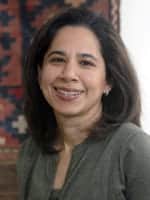Summer intern Melisa had the opportunity to interview Chief Strategy Officer Harsha Thadhani soon after the Women’s World Banking Board approved the organization’s next strategy. They talked about Harsha’s work and Women’s World Banking’s approach to strategic planning.

H: My background is in management consultancy, working in the health care industry for four years. During my time there, we used to work long hours. Three colleagues and I sometimes got together and discussed international development issues outside of work, long talks about all these things about the world. For instance, “if we had only so much money, would you put it in health, in education, in finance?” and we used to get into these very interesting debates. While working there I was introduced to microfinance and to Women’s World Banking. There was an opening to work in the Asia region. Primarily there were practitioners working at the organization then, people that had worked in the field, and they were looking to bring new skillsets.
M: In looking back to those conversations you had with your consulting colleagues, do you think that microfinance is that answer that you were looking for with your colleagues?
H: After 12 years, I think yes (laughs). It is very fulfilling. I think that what we produce here in terms of our publications, our presentations, are as good as the ones that I have seen around. I think what we bring to the table is unique in terms of our perspective and skillset that complement each other when we engage with our outside consulting firms.
M: Since you have been working for Women’s World Banking for so long, could you share with us your path through the organization? Where did you start and how did you end as the Chief Strategy Officer?
H: I started as a Technical Program Associate, in the Asia Team, and worked with network members in the region. When I came, we were going through a strategic planning process that moved the organization towards being more functionally aligned, as opposed to an organizational strategy that was based on region. After we came up with the functional teams, I went to the Strategy team. After a couple of years, we became more strategy, customer research. After that, we developed a more corporate strategy function. And that is when Mary Ellen [Iskenderian, current President and CEO] came on board, about seven years ago, and we agreed to have someone dedicated to the strategic process that we do on a three-year basis. I got involved in looking at business models that Women’s World Banking should consider to become more sustainable, how do to change our business model and move in that direction.
M: In your 12 years with Women’s World Banking, what is the most positive characteristic that you have found in the organization?
H: The one thing that I have seen consistently – with change in leadership, with change in staff – is that everybody is here because they want to be here; they believe in the mission, and they take ownership of what this organization does. You really want to know everything that is going on and you feel very empowered to be in this organization, to provide an opinion, no matter what the discussion is. I think that sense of empowerment and ownership has its advantages and I’ve seen it to be positive because people participate and are involved in what is going on.
M: What has been the most significant experience so far working for microfinance and gender empowerment in these regions?
H: I spent a good amount of time in Sri Lanka many many years ago, working with one of our network members, Sarvodaya (Economic Enterprises Development Services, or SEEDS). They are very grassroots organization that was women-owned, women-managed, so the clients are the ones that lead the organization. It is a very different, unique model, and we had gone at a time where they had very severe portfolio quality issues. We worked with them for about two years, and after the first year the PAR (Portfolio At Risk) fell significantly. That experience was very humbling, very moving. This organization has no English at all. The people that lead the organization come from the communities, from the fields, so you can imagine, the levels of education and sophistication were very basic, yet they understood the implications of what portfolio quality meant, and were able to address it and fix the issue. It took time—over a year—but it happened. It made you see that that kind of investment is worth the return. It was an excellent experience of what fieldwork can do.
M: You are in charge of Women’s World Banking strategic planning – initiatives including the development and monitoring of the organization’s strategic plan. The institution is going through an important change, working together with Bridgespan Group. Do you want to share with us how this process works?
H: We go through this process every three years, and this time around we called it a “Strategy Refresh” because our current strategy, the one that we designed in 2010, that went live in 2011, involved a significant amount of work, figuring out what our vision and theory of change was. In January this year (2013) we were asked by a co-founder to do an external evaluation, and through that evaluation it became clear that what we set out to do is what we are doing, so we are on the right track in terms of our objectives and our goals. But there were clearly improvements needed. So that is the strategy refreshment: building on what has worked over the last two years, and acknowledging that there are gaps, and figuring out how to address those gaps. In this strategy, the theory of change remains pretty much the same, it is still relevant, but the difference is in how we deliver it.



